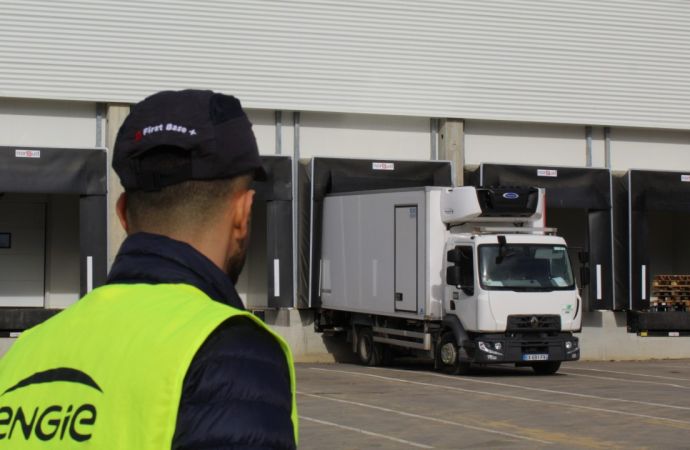The spray chiller technology will deliver 5MW of cooling capacity as well as heat reclaim.

Sysco France, food warehouse in Lagny-le-Sec, France, where an ENGIE NH3/CO2 cascade refrigeration system is being installed.
Since 2018, Sysco France, the Paris-based subsidiary of the global U.S.-based foodservice distributor Sysco, has been engaged in a major renovation and extension of one of its major food warehouses in Lagny-le-Sec, in northern France. Cost of the 22,359m2 (240,670ft2) project: €22 million (US$26 million), including €5 million (US$6 million) for refrigeration.
Sysco France called on French OEM ENGIE Solutions to install a 5MW refrigeration system based on natural fluids (ammonia and CO2) and to make the most of the heat recovered from the system. The installation, which is taking place without interrupting the operation of the site, will be completed by the end of 2020.
In the following interview, Sylvain Specht, Technical Manager for Sysco France, describes the challenging task of redesigning the mega hub at Lagny-le-Sec, and why he chose ENGIE Solutions as a partner to meet its strategic challenges.
WHY REDESIGN YOUR LAGNY-LE-SEC MEGA HUB?
Sylvain Specht: In order to respond to an ever-increasing demand from our customers, in terms of storage capacity. For a long time, customers were dispersing their purchases through specialized service providers, in frozen and chilled products. Today, demand has been reversed. Customers want to centralize their purchases. They want to deal with a single player for all their references – a single location, centralized logistics, identical IT system, etc. It is a guarantee of efficiency and security for them. In the current building of the Lagny-le-Sec mega hub, we process 2,500 frozen products and 1,400 fresh products. Our objective is to be able to manage a total of 7,000 references in order to meet our customers' needs for very large ranges. To achieve this, we are renovating and expanding the site.
WHAT ARE THE ISSUES YOU ARE FACING AT THIS SITE?
Sylvain Specht: There are many of them, which makes the challenge rich and complex. Lagny-le-Sec, like our second mega hub in Pierrelate near Valence (France), is a highly strategic site for us. The requirement is very simple: under no circumstances should the site stop operating. We have no right to make any mistakes. So there are issues of service continuity. In addition, this is a very large site, which inevitably consumes a lot of energy. So there are also performance, energy, economic and environmental issues. Finally, there is the fundamental issue of security – food safety, of course, operational safety, safety for all those working on the site, for which we are responsible, and safety for the inhabitants of the neighboring village. There are many issues, all of which are equally important. A major challenge when you add that the work must not prevent the site from functioning!
YOU HAVE CHOSEN ENGIE SOLUTIONS FOR YOUR REFRIGERATION SOLUTION. WHAT GUIDED YOU IN THIS DECISION?
Sylvain Specht: Given our size, we wanted to be accompanied by an industrial player. While some small logistics companies can work with several small refrigeration units, our size of warehouses requires us to centralize our refrigeration installations to improve performance, regulation and safety. To meet these needs, we needed a player capable of thinking up a global solution that would last over time. ENGIE Solutions is one of the three largest players in its field in France. It is a reference worldwide. It is a refrigeration specialist with proven know-how, experience and resources – an industrialist who knows the needs of industrialists. ENGIE Solutions knows how to manage complex projects with depreciation over 10 years, knows how to propose typical solutions but also how to adapt, knows how to let itself be challenged by its customer to find new solutions. ENGIE Solutions has a different way of approaching projects with a green vision that combines energy, environmental and economic performance, and an ability to measure efficiency.
HOW DID YOU ORGANIZE YOUR COLLABORATION?
Sylvain Specht: On a logic of mutual challenge and dialogue. We have an in-house refrigeration engineering department, Atlantic Réfrigération Consulting, which is working on the project. We had numerous requirements and proposals. I am thinking, for example, of sensors for which we had precise requirements and brands in terms of technical equipment. ENGIE Solutions knows how to propose, recommend, listen to its client and adapt at the same time. Beyond organizational issues, it remains true that the success of major projects depends a lot on the people who carry them out. We are human beings, full of emotions, feelings and preconceptions. The current must flow for the project to move forward. If ENGIE Solutions knows how to be flexible in the choice of technical solutions, it is also the case for human resources. We work with an ENGIE Solutions account manager, whom we really appreciate. ENGIE Solutions has a construction sites branch, but also a services branch which takes care of maintenance. We have set up an operation based on exchange and questioning in order to always do better.
WHAT ENVIRONMENTAL SOLUTIONS HAVE YOU PUT IN PLACE?
Sylvain Specht: In the field of HFC refrigerants and gases, regulations and standards are increasingly restrictive and change every year. Our strategic choice, from the very beginning of the project, was to think in the long term, not in two or five years, but in 20 years. We opted for green technologies, using natural fluids: ammonia and CO2for all the installations. We went further by designing a system that optimizes the use of ammonia, both for safety and economic reasons.
WHAT IS THIS TECHNOLOGY?
Sylvain Specht: We've been working on the issue of the amount of ammonia. Ammonia is a frightening gas because of its irritability, its toxicity. But for more than a century, it has been the most efficient gas in terms of refrigeration. Today, technology and risk control allows us to use this type of gas with a very high level of efficiency and optimized performance. We carried out the project in close consultation with the Mayor of the village, who took part in the work on the layout, landscaping, sound insulation and respect for the environment. And then, with ENGIE Solutions, we set up a specific spraying technology for ammonia. The classic solution using flooded technology consists of circulating fluids in tubes that are immersed in ammonia. This creates an enormous ammonia charge. Our solution is cascade technology using spray chillers. We spray the ammonia on tubes with CO2. This CO2 is then distributed throughout the warehouse. This spray chiller technology allows us to limit the load, to be an installation classified for the protection of the environment (ICPE), because we are less than 1.5 metric tons (3,307lbs) of ammonia for 5 MW (1,422TR) of positive and negative cold. At the scale of our buildings, this has a major impact in terms of savings on work and maintenance.
HAVE YOU ALSO SET UP A HEAT RECOVERY SYSTEM?
Sylvain Specht: Of course! To produce the cold that is useful for preserving fresh food, for freezing and air conditioning, we recuperate the heat released for heating the premises but also for washing trucks, for example. The heat is no longer lost; it is fed to other stations, in a circular logic.
WHAT SAVINGS DO THESE TECHNOLOGIES ALLOW YOU TO MAKE?
Sylvain Specht: We have made financial savings on certain workstations, for example on the pipes I mentioned earlier. We know how to put a figure on our savings for the planet: we avoid 1,400 metric tons of CO2equivalent emissions per year, thanks to our technological choices. In terms of energy consumption for refrigeration, the biggest item in our case, we will have to wait one or two years to do the accounts, even though we know for sure that we are going to make significant energy savings.
HOW DO YOU TRACK YOUR ENERGY CONSUMPTION?
Sylvain Specht: ENGIE Solutions has set up piloting and monitoring tools, with their automation service. They enable the measurement of the energy spent. The aim for us is to be able to say one day how much energy a pallet of goods consumes in a year. Knowing the cost in kilowatts spent per pallet will enable us to control our logistics costs and achieve a level of performance that is profitable to our customers. The more our warehouses are loaded and the more we benefit from the inertia of the products, the less we will need to cool the products by external energy sources. The strength of our work with ENGIE Solutions lies precisely in this global approach: imagining solutions, budgeting them, implementing them and monitoring them via a reporting system that relates the cost of the solution to the cost of production.
DO THE MONITORING SYSTEMS IN PLACE ALSO ALLOW YOU TO MAINTAIN YOUR HIGH LEVEL OF SECURITY?
Sylvain Specht: They are indispensable in this regard. We have sensors everywhere, distributed according to the areas – air conditioning, refrigeration, air treatment, fire protection. We have, for example, specific sensors to detect if there is CO2in ammonia. These two fluids have to exchange calories but without ever touching each other, otherwise there is a risk of creating a chemical solidification reaction that blocks everything. Real-time sensors allow us to monitor whether there is contact and, if this is the case, to isolate the fluids in a few thousandths of a second. As the functional safety of our site is fundamental, all our installations are redundant – spray chillers, electrical installations. Everything is doubled to guarantee continuity of operation in all circumstances.
FOOD SAFETY IS ONE OF YOUR CENTRAL ISSUES, BUT ALSO THAT OF THE PEOPLE WORKING ON YOUR SITE?
Sylvain Specht: Indeed, the safety of our staff, but also of all those working on site, has been a central topic of our reflection. We have worked with ENGIE Solutions to develop maintenance solutions that guarantee the safety of all those involved: footbridges, stairs, attic walkways, pedestrian traffic, access. Everything has been thought out to avoid accidents, make access and maintenance easier and safer. This was also the meaning of a centralized installation that allows maintenance to be optimized without multiplying the sources of breakdowns. We worked with the services branch of ENGIE Solutions on all these issues.
THE PROJECT SHOULD BE COMPLETED BEFORE THE END OF 2020. WHAT LESSONS HAVE YOU ALREADY LEARNED FROM IT?
Sylvain Specht: We went all the way, thinking of a global solution that represents significant investments but does not cut back on any of our key issues: safety and environmental performance. We thought big, systemically, daring to innovate, to think outside the box and to be ahead of the future. This has been made possible by concerted work between the players – crosscutting, cross-functional thinking to find solutions adapted to our specific case. ENGIE Solutions succeeded in the challenge of being a force for proposals while constantly adapting to our situation, our needs and our wishes. They invest themselves with their client, in the interest of the project.
We carried out the project in close consultation with the Mayor of the village, who took part in the work on the layout, landscaping, sound insulation and respect for the environment."
– Sylvain Specht, Sysco France
Related stories



